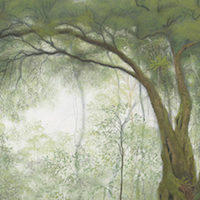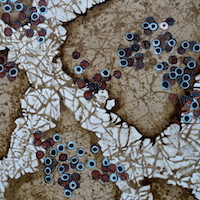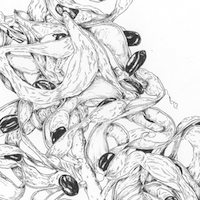—part of the ASBS 2018—Mind the gap conference—
Systems is an exhibition that celebrates the diverse and curious biological systems of Australia’s living world.
Coinciding with the Australasian Systematic Botany Society 2018 conference, Mind the Gap, this exhibition showcases South East Queensland-based artists who take inspiration from living systems, revealing links between art, science and nature.
Systems will be launched during the conference welcome reception.
Systems artist Alinta Krauth will be presenting a one-night only art installation for the conference welcome reception, to be experienced outside in the Australian tropical rainforest section of the gardens. Have a look at a similar piece she’s done before.
| Alinta Krauth is a new media art practitioner and researcher. She uses her practice to highlight environmental degradation, where she has worked alongside, and has been inspired by, scientific disciplines and concepts of relational ontology. | 
Walking Relationally—an ephemeral event, 2018 (detail). Five animations, size variable. Photo by Engage Arts, courtesy of the artist. |
| Clare Poppi explores how jewellery can leave marks, not only on the body, but also on our souls. | 
Seed Bomb Necklance, 2018 (detail). Sterling silver, clay, compost, seeds, cotton rope, 45 x 60 cm. Photo by Faun Photography, courtesy of the artist. |
| Donna Davis is a multi-discipline artist intrigued with the idea of connection—her work explores intersections between art and science with a particular focus on natural and social ecosystems. | 
Untitled (Northern Bettong project), 2018 (detail). Mixed media: soft sculpture, wire, fabric, mirrors, plastic, 60 x 60 x 60 cm. Image courtesy of the artist. |
| Nicola Hooper uses drawing and lithography as a narrative tool to consider the subversive in nature. Exploring our conflicted perception of animal hosts in the context of their association with zoonoses and the positive role that ‘good animals’ take in scientific testing. | 
She the Cannonball Tree, 2014. Hand coloured lithograph. Image courtesy of the artist. |
| Paula Peeters is an artist and writer, creating images and stories that create a warm and wondrous response the viewer’s heart or mind, or both—in the hope that this might create a ripple, which might lead to change. | 
Nothofagus forest, south east Queensland, 2013 (detail). Pastel on paper, 96 x 74.5 cm. Image courtesy of the artist. |
| Rachael Lee is an intuitive printmaker using various printmaking techniques to create layered images investigating visual perception and the underlying patterns, rhythms and codes found in nature. | 
Blush, 2011 (detail). Linocut, stencil on Saunders Waterford paper, 45.7 x 44.8 cm. Image courtesy of the artist. |
| The work of Renata Buziak draws on natural science and extensive consultations and discussions with members of the Quandamooka community of Minjerribah (North Stradbroke Island). The images of medicinal plants are based on the fusion of organic and photographic materials in a process of decomposition that I name the biochrome. | 
Eucalyptus tereticornis …therapeutic… II, 2014 (detail). Archival pigment on Hahnemuhle Torchon paper, 150 x 120 cm. Image courtesy of the artist. |
| Sandra Pearce is a maker of artist books, printed imagery and paper installations incorporating distinctive textural and colourful printmaking techniques. Sandra’s work examines the notion of boundaries, domestication, and the manipulation of landscape—focussing on nature–human conflicts. The artist is particularly interested in the impact of urbanisation on the biodiversity of native wildlife and plants. | 
Interconnection, 2015–18 (detail). Hexagon paper shapes, dimensions variable. Photo by Leeroy Todd Photography, courtesy of the artist. |
| The work of Svetlana Trefilova explores the dualities of the world around us that is visible and invisible. Svetlana looks into the microscopic world of Australian nature—perhaps a fictional world, but another world nonetheless. The resulting abstract phenomena allow viewers to see and perceive the invisible world surrounding us. | 
Myrtle Rust series (Spores I), 2017–18 (detail). Ink on paper, 60 x 84 cm. Image courtesy of the artist. |
| Tanya Scharaschkin is a botanist and an artist. Her research interests include understanding evolutionary relationships and studying the structure of plants. Tanya primarily uses ink and graphite in her botanical artwork with some application of water colour and coloured pencils. | 
Wattle fruits, 2015 (detail). Ink on paper, 34 x 42 cm. Image courtesy of the artist. |
